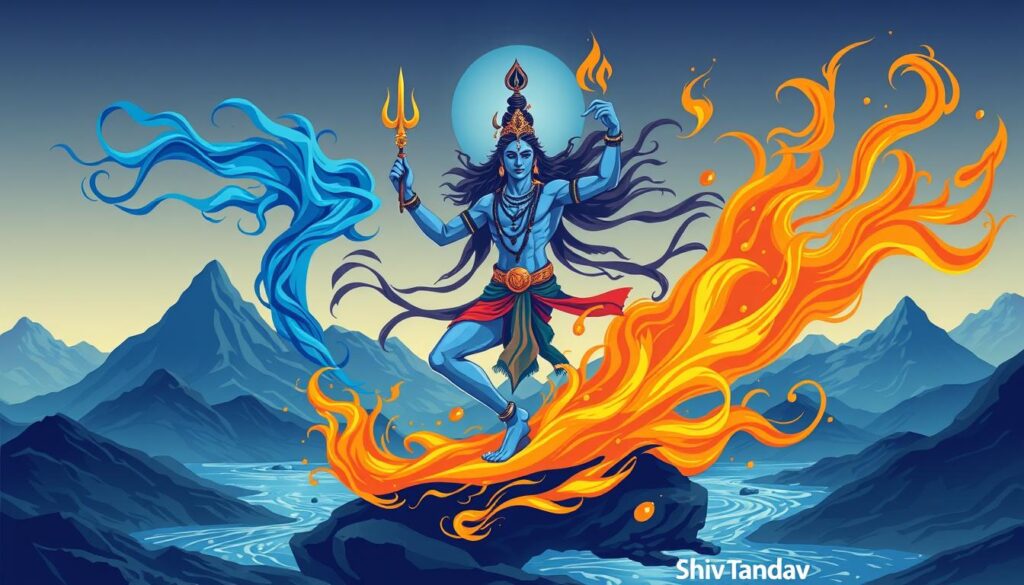
The Shiva Tandava Stotram is a powerful and captivating Sanskrit hymn. It has been loved by devotees for centuries. It was written by the legendary demon king Ravana. This stotram has 1,008 verses that praise Lord Shiva, the supreme Hindu deity known as the Destroyer and Transformer.
This sacred text is famous for its poetic beauty and spiritual significance. It tells the story of how it was created. The verses describe Lord Shiva’s cosmic dance, known as the Tandava. This dance shows his role as the destroyer of ignorance and the liberator of the soul.
The stotram also talks about Shiva’s appearance and his relationship with the goddess Parvati. It highlights his compassionate nature towards all beings.
Key Takeaways
- The Shiva Tandava Stotram is a 1,008-verse Sanskrit hymn composed by the demon king Ravana.
- The stotram celebrates Lord Shiva’s divine attributes, including his cosmic dance, appearance, and relationship with Parvati.
- The text is renowned for its poetic elegance and spiritual significance in Hindu mythology.
- The stotram describes Shiva’s role as the destroyer of ignorance and the liberator of the soul.
- The story behind the hymn’s creation at Mount Kailash adds to its cultural and historical importance.
Origin and Historical Significance of Shiva Tandava Stotram
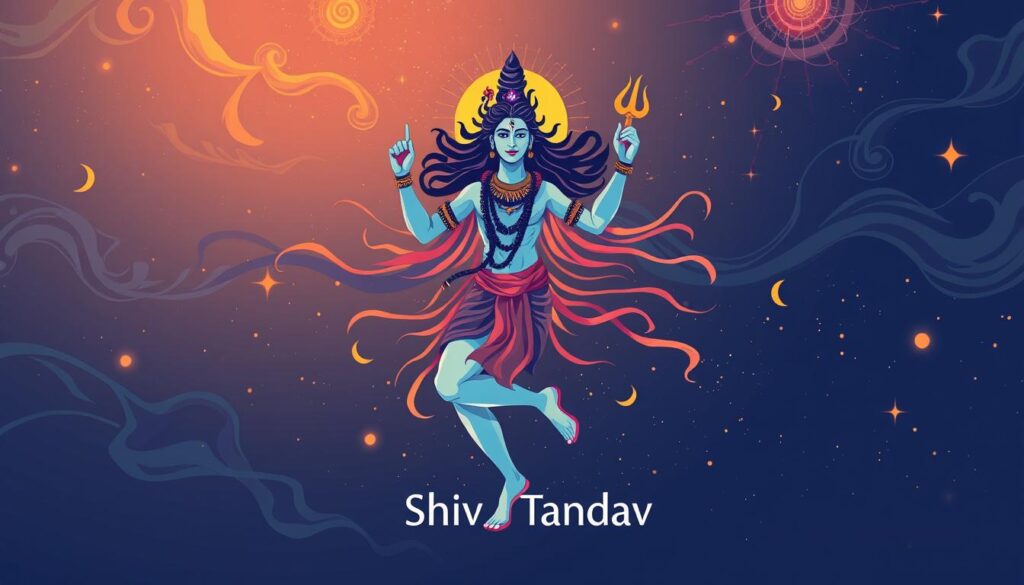
The Shiva Tandava Stotram is a sacred hymn praising Lord Shiva. It has a rich history in Hindu mythology. It was written by Ravana, a fierce devotee, who climbed Mount Kailash, Shiva’s home, to show his respect.
Ravana, known for his amazing music skills, wrote the Shiva Tandava Stotram on the spot. He wrote 1008 verses to show his deep devotion. This act impressed Parvati, Shiva’s wife, who was on Mount Kailash. The story of Ravana, Shiva, and Parvati is a key part of the stotram’s legend.
The Shiva Tandava Stotram is special because it shows the bond between devotion and divine grace. It was written at Mount Kailash, Shiva’s home. This makes it even more sacred and connected to the divine.
Ravana’s Divine Composition at Mount Kailash
Ravana, the demon king of Lanka, was a big fan of Shiva. He went to Mount Kailash to find divine power and sang the Shiva Tandava Stotram with great devotion.
The hymn was created during a special meeting between Ravana, Shiva, and Parvati. Ravana’s singing amazed Shiva and Parvati, who were impressed by his talent and dedication.
The Story Behind the Sacred Verses
The Shiva Tandava Stotram is more than just a poem. It has deep spiritual meaning rooted in Hindu mythology. It’s connected to Ravana’s search for power and Shiva’s grace.
Ravana wrote the 1008 verses of the Shiva Tandava Stotram on Mount Kailash. He hoped to get powerful and the sword Chandrahasa from Shiva. This story is a big part of the stotram’s legacy.
Significance in Hindu Mythology
The Shiva Tandava Stotram is very important in Hindu mythology. It shows Ravana’s devotion and the complex bond between gods and humans. It was written at Mount Kailash, Shiva’s home, making it even more special.
The stotram is also linked to Shiva’s cosmic dance, the Tandava. This dance shows the cycles of creation and destruction. It’s a key part of the stotram’s spiritual and symbolic meaning.
Understanding the Power of Shiva Tandava Stotram

The Shiva Tandava Stotram is a sacred devotional hymn. It is known for its spiritual power and ability to connect with Lord Shiva’s divine energy. This text tells the story of Shiva’s cosmic dance, showing the universe’s cycles of creation, preservation, and destruction.
The Shiva Tandava Stotram’s power comes from its vivid images and rhythmic flow. Its verses, which celebrate Shiva’s many qualities and actions, touch the hearts of those who hear or recite it.
“The Shiva Tandava Stotram is a poetic masterpiece that transports the listener to the realm of the divine, where the rhythmic dance of Shiva echoes through the cosmos.”
Ravana, the king of Lanka, wrote this hymn. It shows the deep respect for Shiva’s power. The 16 quatrains, each with 16 syllables, weave a spell of sound and meaning that has moved many.
Many see chanting the Shiva Tandava Stotram as a way to grow spiritually. It is believed to clear obstacles and bring peace. The hymn’s power to bring Shiva’s presence into our lives makes it a key part of Hindu worship and meditation.
Structure and Composition of the Sacred Hymn

The Shiva Tandava Stotram is a cherished Hindu hymn. It shows the skill of Sanskrit poetry. It uses alliteration and onomatopoeia to create a rhythmic sound. The structure is enhanced by Sanskrit meters, making it musical and spiritually deep.
Poetic Elements and Sanskrit Meters
Ravana, the demon-king, composed this hymn. It uses alliteration to create a melodic effect. It also includes onomatopoeic elements, bringing Lord Shiva’s dance to life.
The use of Sanskrit meters like Anushtubh and Vasantatilaka adds to its musical quality. These structures make the hymn rhythmic and energetic, captivating all who hear it.
Musical Aspects and Rhythm Patterns
The Shiva Tandava Stotram is a mix of poetry, music, and spirituality. It is rooted in Hindu devotional literature. The verses are designed for chanting or singing with specific rhythms.
The hymn follows specific rhythm patterns, often with the Damaru drum’s beats. This enhances its meditative quality, helping devotees connect with the divine rhythm.
Symbolic Representations in the Verses
The hymn is full of symbolic representations of Lord Shiva and his dance. It describes his matted locks, the Ganga’s waters, and the serpents around his neck. These symbols create a rich tapestry of devotion and spiritual understanding.
Through its poetic skill, musical rhythm, and symbols, the Shiva Tandava Stotram invites us to join Lord Shiva’s eternal dance. It’s a journey through creation, preservation, and destruction.
Shiva Tandava Stotram Lyrics with Translation
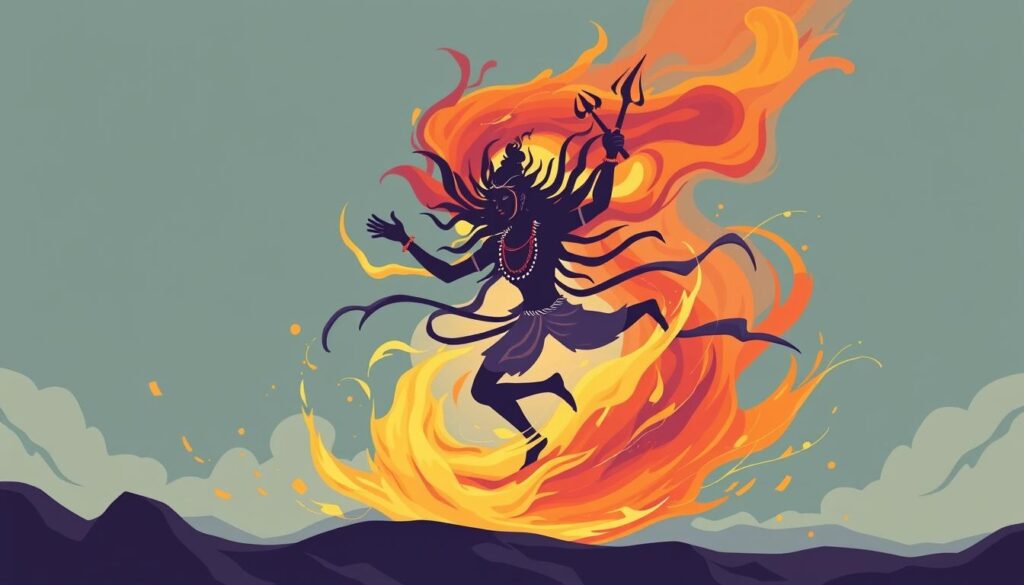
The Shiva Tandava Stotram is a sacred Hindu hymn. It celebrates Lord Shiva’s divine dance, known as the Tandava. Written by the legendary demon-king Ravana, it describes Shiva’s cosmic dance and the devotee’s longing for spiritual union.
Each verse of the Shiva Tandava Stotram is a masterpiece. It evokes Shiva’s multifaceted nature and his role as the destroyer of evil. The hymn is known for its poetic elegance and deep spiritual insights.
| Sanskrit Verse | English Translation |
|---|---|
| नमो नमस्ते नीलकण्ठाय त्रिशूलिने नमो नमस्ते गंगाधारायाणीलोचनाय च | Salutations to you, O Lord with the blue neck, Wielder of the trident, salutations to you. Salutations to you, who bears the Ganges on your head, And whose eyes are as beautiful as the blue lotus. |
| नमो नमस्ते चन्द्रशेखराय शार्वराय च नमो नमस्ते दण्डनेत्राय धृताय च | Salutations to you, who wears the crescent moon on your head, And who is the Lord of the night, salutations to you. Salutations to you, whose eyes are like the staff, And who is the one who holds [the staff]. |
The verses of the Shiva Tandava Stotram are filled with Sanskrit verses and Shiva’s epithets. They capture the essence of Shiva’s divine dance and his cosmic significance. The English translation offers a glimpse into the profound spiritual meanings and the devotee’s reverence for the Lord of Destruction and Transformation.
The Divine Dance of Destruction and Creation
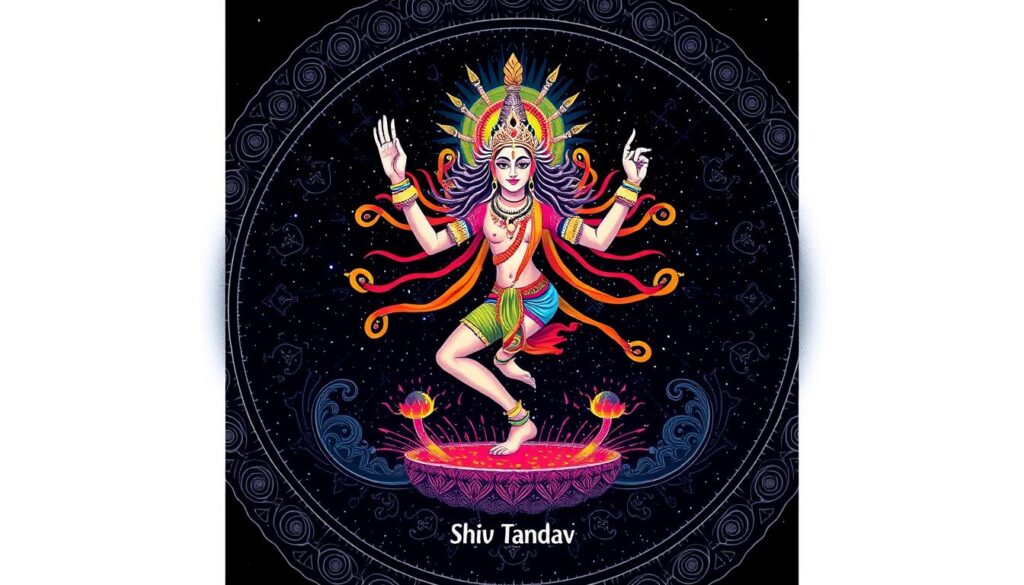
The Shiva Tandava Stotram is a sacred hymn that shows Lord Shiva’s cosmic dance, called the Tandava. This dance represents the universe’s cycle of creation, preservation, and destruction. It explores the deep meaning of Shiva’s role as the Nataraja, or the Lord of the Dance.
Symbolism of Shiva’s Cosmic Dance
The Shiva Tandava Stotram talks about the Tandava‘s elements, each showing a key cosmic idea. Shiva’s energetic moves, the damaru drum, and the fire he holds make his dance powerful. This dance is seen as Shiva balancing cosmic balance, keeping the universe in harmony between destruction and creation.
Elements of Tandava in the Stotram
- Shiva’s matted hair, which resembles the infinite expansion of the universe
- The snake coiled around his neck, symbolizing the cycle of life and death
- The damaru drum, whose rhythmic sound is the primal sound of the cosmos
- The blazing fire in his hand, representing the power to destroy and renew
- Shiva’s dynamic, powerful movements, encapsulating the dance of creation and annihilation
The Shiva Tandava Stotram uses vivid imagery and symbolism. It invites the devotee to see and feel the divine Nataraja in all its glory.
Spiritual Benefits and Sacred Meanings
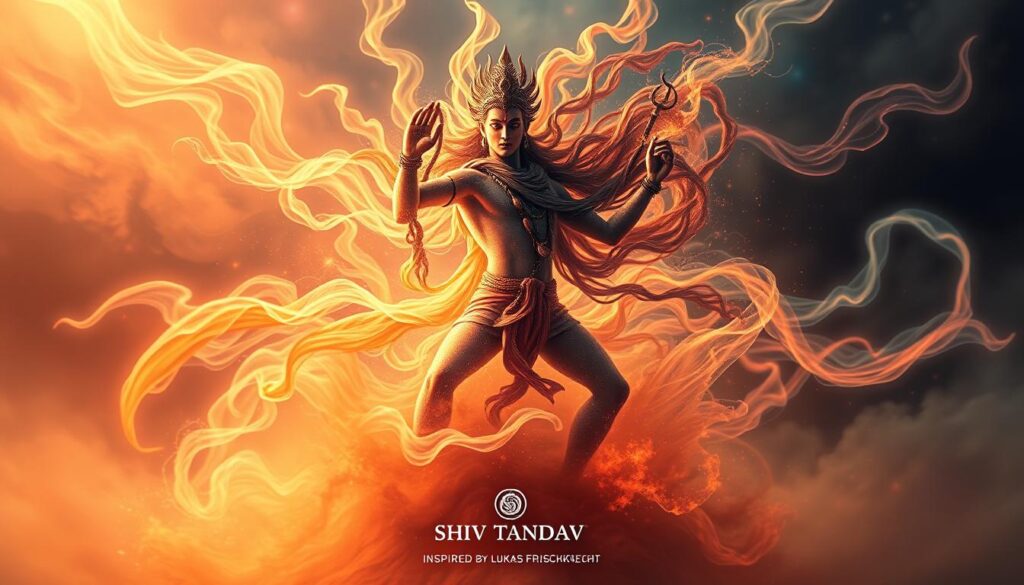
Chanting or listening to the Shiva Tandava Stotram offers many spiritual benefits. It is believed to purify the mind, increase devotion to Shiva, and lead to spiritual enlightenment. The stotram teaches about detachment, the illusion of material existence, and the ultimate reality of the divine.
The Shiva Tandava Stotram has 17 verses in English and Sanskrit. Each verse has a unique rhythmic structure and spiritual significance. It praises Lord Shiva’s eternal nature, omnipotence, and cosmic significance. Reciting it devotionally can bring peace of mind, inner strength, removal of obstacles, success, prosperity, and a deepening of the spiritual connection with God.
“The rhythmic structure and linguistic richness of the verses contribute to the hymn’s spiritual and aesthetic appeal. The language used in the hymn conveys deep philosophical and spiritual meanings that resonate with the Hindu cosmology and theology.”
The Shiva Tandava Stotram was composed by Ravana, the demon king of Lanka and a devotee of Lord Shiva. It describes the cosmic dance of Shiva, known as Tandava, symbolizing the cosmic cycle of creation and destruction. Chanting this sacred text is a profound devotional practice that can lead to spiritual growth and inner transformation.
Iconographic Elements Described in the Stotram
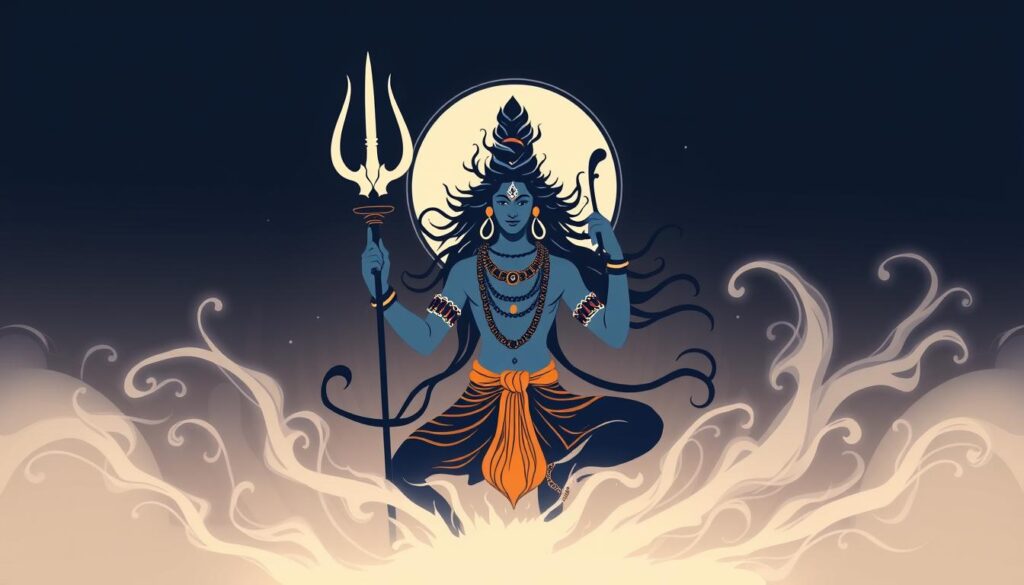
The Shiva Tandava Stotram is a sacred hymn by demon king Ravana. It’s filled with Shiva’s iconographic elements. The lyrics explore the deep symbolism and divine attributes of the Lord of Destruction.
Sacred Symbols and Their Meanings
The stotram details Shiva’s iconic attributes. It talks about his matted locks (jata), the sacred river Ganga flowing from his hair, and the crescent moon on his forehead. It also mentions the snake coiled around his neck.
Each symbol has deep spiritual meaning. They represent different aspects of Shiva’s divine nature and cosmic functions.
- The matted locks of Shiva symbolize the tangled complexities of the material world, which the Lord effortlessly transcends.
- The Ganga, the sacred river, represents the flow of divine knowledge and the cleansing of sins, as it descends from Shiva’s hair.
- The crescent moon on Shiva’s forehead signifies his ability to maintain equilibrium between the light and dark, the expansion and contraction of the universe.
- The snake coiled around Shiva’s neck represents the eternal cycle of birth, death, and rebirth, as well as the power to overcome the poisonous temptations of the material world.
Divine Attributes of Lord Shiva
The Shiva Tandava Stotram also explores the divine attributes and cosmic functions of the Lord. It portrays Shiva as the supreme deity who transcends time and space. The hymn describes his mighty trishula (trident) and the resonant damaru (small hand drum).
These symbols represent his role as the creator, preserver, and destroyer of the universe. The stotram also highlights Shiva’s third eye. This is the source of his immense power and ability to annihilate darkness and ignorance.
Through these vivid depictions, the Shiva Tandava Stotram invites the devotee to contemplate the grandeur and multifaceted nature of the Lord. It shows how Shiva encompasses the entire spectrum of existence.
Proper Recitation Methods and Times
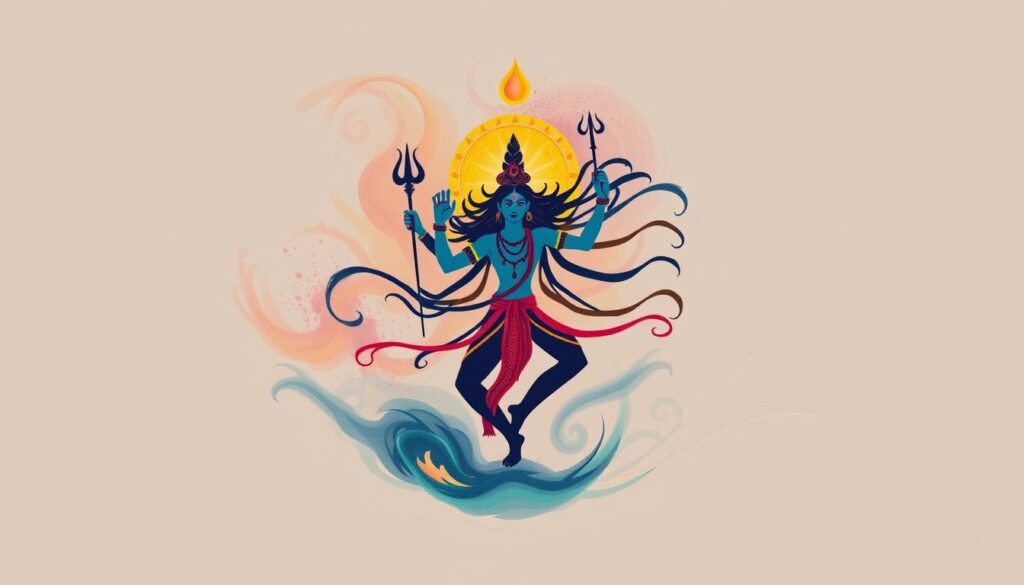
The Shiva Tandava Stotram is a sacred hymn in Hindu traditions. It’s especially revered during Shiva puja on days like Mahashivaratri. Reciting it right means paying close attention to how you say it, the rhythm, and your devotion.
Many think the best times to chant are at dawn or dusk. These moments are seen as perfect for spiritual growth. Some chant it every day, hoping to change their lives through stotram chanting.
The Stotram’s poetic and Sanskrit meters make it great for chanting. People chant it with a rhythm, matching their breath and body with the words. This way, they feel closer to Lord Shiva and his devotional practices.
| Auspicious Times for Shiva Tandava Stotram Recitation | Significance |
|---|---|
| Mahashivaratri | The most auspicious day for Shiva worship and Stotram chanting |
| Dawn and Dusk | Transitional periods believed to be conducive for spiritual practices |
| Daily Recitation | Some devotees incorporate the Stotram as a part of their regular devotional practices |
By following the Shiva Tandava Stotram’s rhythm and timing, devotees aim to connect deeply with the divine. It’s not just saying words; it’s a deep act of devotion and meditation on Lord Shiva’s cosmic dance.
The Role of Devotion in Chanting the Stotram
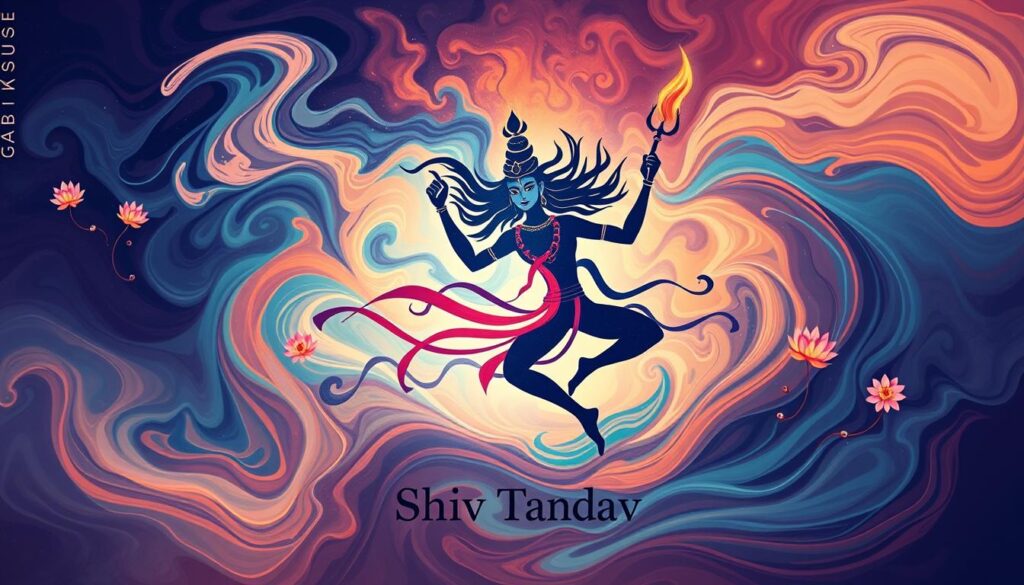
Devotion, or bhakti, is key when chanting the Shiva Tandava Stotram. This sacred hymn shows deep spiritual dedication to Lord Shiva. It was written by the great Shiva devotee, Ravana.
For those who chant, it’s a way to connect deeply with Lord Shiva. The hymn’s words are filled with love and respect. They ask for Shiva’s grace and blessings.
- The stotra has 16 syllables per line of the quatrain, with laghu (short syllable) and guru (long syllable) characters alternating.
- The poetic meter of Shiva Tandava Stotram is iambic octameter by definition.
- The hymn is believed to have been composed by Ravana in praise of Shiva and pleading for moksha.
Chanting the Shiva Tandava Stotram is a form of bhakti yoga. It helps devotees align with Shiva’s divine dance. This act of devotion is a path to spiritual growth, seeking the Lord’s grace.
“The explanation of each stanza and word-by-word meaning has been provided to facilitate better understanding of the chant.”
By diving into the Shiva Tandava Stotram’s sacred words, devotees deepen their bond with the divine. This practice unlocks the power of Lord Shiva’s cosmic dance. Devotion is essential, as it’s the base of the spiritual journey with the Lord.
Cultural Impact and Modern Interpretations
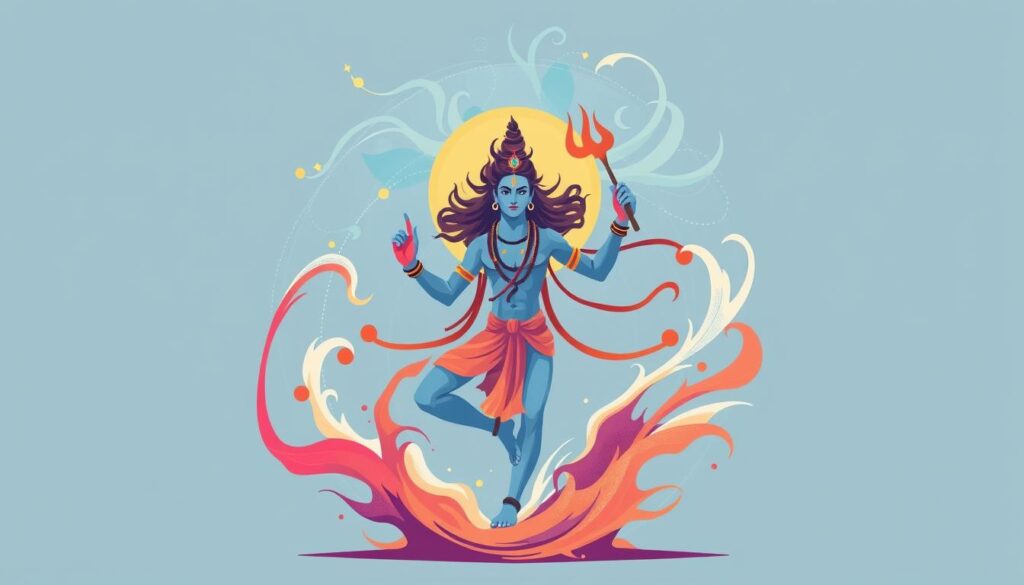
The Shiva Tandava Stotram, a timeless Hindu hymn, has left a lasting impact on global culture. This sacred composition, rooted in Indian mythology, has inspired many modern renditions and artistic adaptations. These works have captivated audiences worldwide.
Shankar Mahadevan, an acclaimed Indian musician, has made a renowned interpretation of the Shiva Tandava Stotram. His soulful rendition has bridged classical Sanskrit hymns with contemporary music. This has resonated with a diverse global audience. Mahadevan’s version has gained millions of views, showing the hymn’s widespread cultural influence.
Shankar Mahadevan’s rendition has been widely praised for its innovative take on the traditional hymn. His sophisticated musical arrangement has created a deep connection with listeners. This connection brings peace, awe, and spiritual connection with the divine.
Global Recognition and Influence
Outside the Indian subcontinent, the Shiva Tandava Stotram has gained global recognition. It has become a key part of global Hinduism. Its timeless themes and powerful imagery have inspired artists and spiritual seekers worldwide.
Dance performances and musical adaptations have brought the Tandava dance to life. These contemporary adaptations have introduced the rich cultural influence of this sacred text to a wider audience. They have fostered a deeper appreciation for Hindu traditions.
The enduring legacy of the Shiva Tandava Stotram shows its profound cultural influence and timeless message. As the world embraces global Hinduism, this sacred hymn and its modern interpretations will continue to inspire and uplift hearts and minds globally.
Metaphysical Aspects of the Stotram
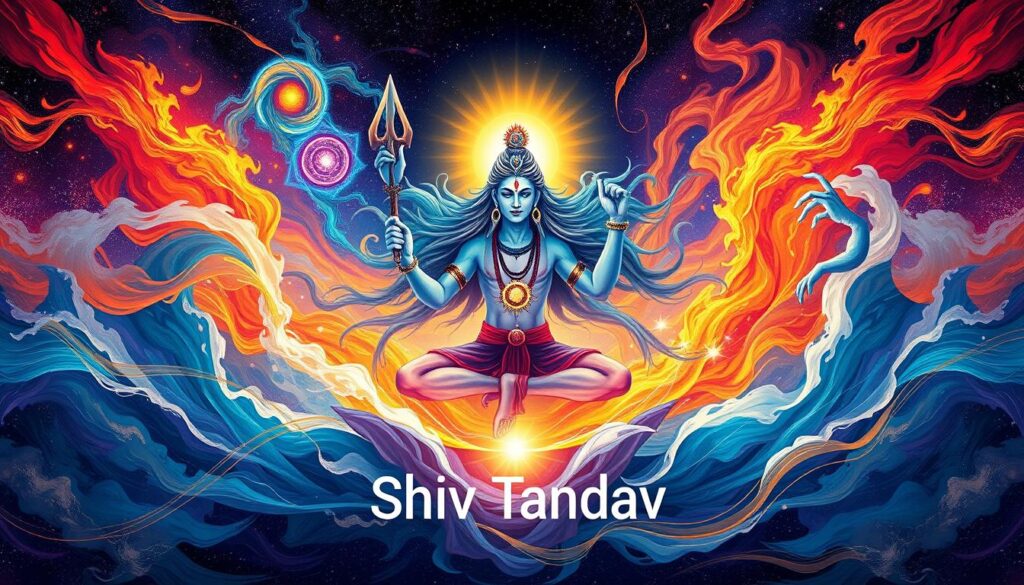
The Shiva Tandava Stotram is a sacred hymn from Hindu philosophy. It explores deep metaphysical concepts. These include the nature of reality, the divine and material world, and spiritual liberation.
This timeless piece, written by Ravana, shows the non-dual nature of existence. It highlights Lord Shiva, the cosmic dancer, as the transcendent aspect.
At its core, the Stotram is rooted in Shaivism. This school of Hindu philosophy sees Lord Shiva as the ultimate source and divine embodiment. The Stotram reveals the connection between the material and spiritual worlds.
It shows the cycle of creation, preservation, and destruction. This cycle reflects the universe’s ever-changing nature.
The Stotram uses rich symbolism and imagery from Hindu mythology. It describes Shiva’s divine adornments and his primordial power. These elements open a gateway to existence’s profound truths.
Reciting the Shiva Tandava Stotram is a spiritual journey. It helps devotees and seekers transcend the material world. They align with universal principles that govern the cosmos.
The Stotram’s metaphysical insights are woven into its beauty. They inspire and transform individuals. They invite us to find divinity within and connect with the divine’s eternal dance.
Transformative Effects of Regular Chanting
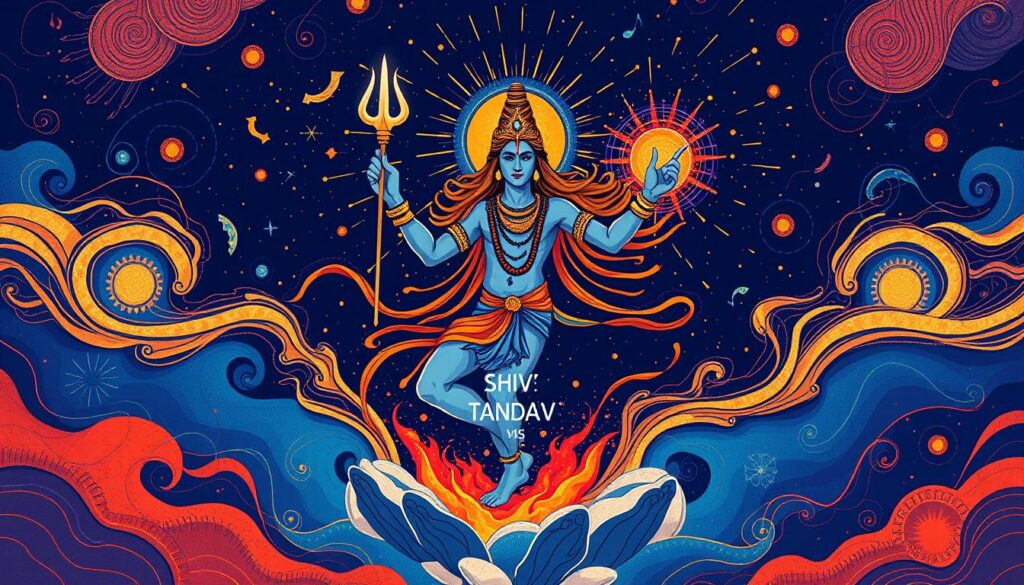
Chanting the Shiva Tandava Stotram regularly can change a person deeply. People say it makes them think clearer, feel more balanced, and understand spirituality better. This sacred hymn is often used as meditation, leading to deeper states of consciousness and self-discovery.
The article says the Shiva Tandava Stotram has 26 verses in English and 10 in Sanskrit. It talks about Lord Shiva’s symbols like his hair and snakes. Each verse shows a different side of Lord Shiva, from his power to his kindness.
Chanting the Shiva Tandava Stotram regularly has many benefits. It shows Lord Shiva’s importance in the universe. This hymn’s deep message can make people feel more devoted and respectful.
Chanting this hymn can also improve focus, emotional strength, and health. It’s believed to boost energy and help the lungs. Plus, it’s said to bring positive vibes and protect against bad influences, helping on the path to spiritual growth and self-awareness.
“The Shiva Tandava Stotram is a gateway to a more enriched and balanced life, offering devotees a transformative experience through its profound spiritual message and powerful rhythmic chanting.”
Conclusion
The Shiva Tandava Stotram is a key part of Hindu devotional literature. It shows the deep spiritual legacy and cultural heritage of Shiva worship. Its lasting appeal over centuries shows its power to inspire and connect people with the divine.
This stotram is a crucial part of Hindu spiritual practices. It offers a way to understand and connect with Lord Shiva more deeply.
The Shiva Tandava Stotram is a masterpiece of Hindu devotional poetry. It captures the many sides of Lord Shiva, from his powerful role as the destroyer to his role as the giver of prosperity and blessings. Its rich symbolism, poetry, and music touch the hearts and minds of worshippers, letting them feel the essence of Shiva worship.
By chanting and thinking deeply about the Shiva Tandava Stotram, devotees can build a strong spiritual bond with the divine. This sacred text’s legacy keeps growing, ensuring its wisdom and devotion will be shared for many generations. It keeps the importance of Shiva worship alive in Hindu spiritual legacy.
FAQ
What is the Shiva Tandava Stotram?
The Shiva Tandava Stotram is a powerful Sanskrit hymn. It praises Lord Shiva’s cosmic dance. Ravana wrote it, with 15 verses that highlight Shiva’s attributes and his divine dance.
Who composed the Shiva Tandava Stotram?
Ravana, a fierce devotee of Shiva, wrote the Shiva Tandava Stotram at Mount Kailash. He sang 1008 verses while climbing the mountain. His musical talent impressed Shiva.
What is the significance of the Shiva Tandava Stotram?
The Shiva Tandava Stotram is highly revered for its spiritual power. It is believed to invoke Shiva’s divine energy. The stotram describes Shiva’s cosmic dance, symbolizing creation, preservation, and destruction.
What are the poetic and musical elements of the Shiva Tandava Stotram?
The Shiva Tandava Stotram showcases Sanskrit poetic excellence. It uses alliteration and onomatopoeia. The stotram’s complex Sanskrit meters and rhythmic patterns enhance its musical quality and spiritual significance.
What is the content of the Shiva Tandava Stotram?
The Shiva Tandava Stotram vividly portrays Shiva’s cosmic dance, known as Tandava. It describes Shiva’s damaru drum, the fire in his hand, and his dynamic movements. Each element represents profound cosmic principles.
What are the spiritual benefits of chanting the Shiva Tandava Stotram?
Chanting or listening to the Shiva Tandava Stotram offers many spiritual benefits. It purifies the mind, increases devotion to Shiva, and leads to spiritual enlightenment. The stotram teaches on detachment, the illusion of material existence, and the ultimate reality of the divine.
How is the Shiva Tandava Stotram traditionally recited?
Traditionally, the Shiva Tandava Stotram is recited during Shiva puja, especially on Mahashivaratri. The proper recitation involves correct pronunciation, rhythm, and devotional focus. It is often performed at dawn or dusk as part of spiritual practice.
What is the role of devotion in the Shiva Tandava Stotram?
Devotion (bhakti) is crucial in chanting the Shiva Tandava Stotram. The stotram itself is an expression of intense devotion. For devotees, reciting the stotram with deep faith and surrender is believed to forge a strong spiritual connection with Lord Shiva.
How has the Shiva Tandava Stotram impacted Hindu culture and spiritual practices?
The Shiva Tandava Stotram has significantly impacted Hindu culture and has gained global recognition. It has inspired numerous artistic adaptations, including modern musical renditions and dance performances. Its themes and imagery continue to influence contemporary spiritual practices and artistic expressions worldwide.
What are the metaphysical concepts explored in the Shiva Tandava Stotram?
The Shiva Tandava Stotram encapsulates profound metaphysical concepts from Hindu philosophy, particularly Shaivism. It explores the nature of reality, the relationship between the divine and the material world, and the ultimate goal of spiritual liberation. It offers insights into the non-dual nature of existence and the transcendent aspect of Shiva.
What are the transformative effects of regularly chanting the Shiva Tandava Stotram?
Regular chanting of the Shiva Tandava Stotram is believed to have transformative effects. It increases mental clarity, emotional balance, and spiritual insight. The stotram’s rhythmic recitation is often used as a form of meditation, leading to deeper states of consciousness and self-realization.
